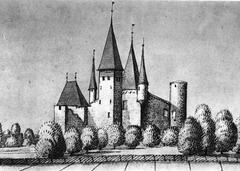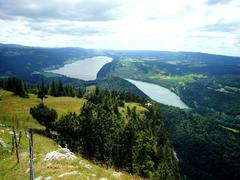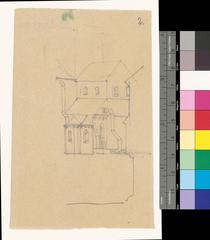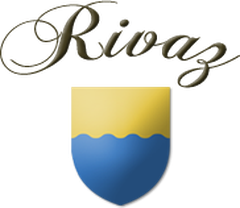Bolo Museum Visiting Hours, Tickets, and Guide to Canton Vaud Historical Sites
Date: 15/06/2025
Introduction
Musée Bolo, located on the campus of the École Polytechnique Fédérale de Lausanne (EPFL) in Switzerland’s Canton of Vaud, stands as one of Europe’s most significant institutions dedicated to computing history and digital culture. Evolving from the personal collection of engineer Yves Bolognini, the museum now preserves and showcases an extensive range of artifacts that trace the story of digital technology, from pioneering Swiss-made computers to iconic supercomputers and video game consoles. Open to the public free of charge, Musée Bolo offers accessible insight into the relationship between humans and machines, making it an essential stop for technology enthusiasts, families, scholars, and tourists alike (Musée Bolo History, Lausanne Musées, Medium: Bolo Museum).
This guide offers a detailed overview of Musée Bolo’s visiting hours, ticketing, exhibitions, accessibility, and tips to enrich your visit, as well as highlights of Lausanne’s nearby historical attractions.
Table of Contents
- Historical Background and Significance
- Visiting Musée Bolo: Hours, Tickets, and Location
- Exhibitions and Educational Mission
- Community Engagement and Events
- Challenges and Future Prospects
- Cultural and Historical Impact
- Frequently Asked Questions (FAQ)
- Plan Your Visit and Stay Connected
- References and Further Reading
Historical Background and Significance
Origins and Development
The roots of Musée Bolo reach back to 1995, when Yves Bolognini began collecting computers in his student apartment. Inspired by Swiss computing pioneers such as Professor Jean-Daniel Nicoud (creator of the Smaky computer), the collection quickly expanded. By 2001, the Association “Les Amis du Musée Bolo” was established to formalize preservation efforts (Musée Bolo History). The museum officially opened in 2002 in space provided by the EPFL, becoming Switzerland’s first permanent exhibition dedicated to computing history (Lausanne Musées).
In 2007, the Mémoires Informatiques Foundation was created to ensure the long-term management and legal protection of the museum’s growing collection (Medium: Bolo Museum). Today, the museum operates as a private institution, relying on a dedicated base of volunteers and community support.
Collection and Significance
Musée Bolo is recognized for one of Europe’s largest collections of computing artifacts. It includes:
- Swiss-made computers: Notably the Smaky series, developed at EPFL.
- Supercomputers: Including the Cray 2 and IBM Blue Gene.
- Video game history: Expanding to consoles and digital entertainment.
- International outreach: Lending items to other museums and collaborating with institutions across Europe (Musée Bolo History).
Only a fraction (~3%) of the collection is on public display at any time; the rest is preserved in off-site storage. Nevertheless, the museum stands as a vibrant hub for digital heritage, education, and reflection on society’s technological evolution (Lausanne Musées).
Visiting Musée Bolo: Hours, Tickets, and Location
Visiting Hours
- Monday to Friday: 8:00 AM – 7:00 PM
- Closed: Saturday, Sunday, and during Christmas school holidays
Note: Always verify hours on the official website before visiting, as they may change for holidays or special events.
Tickets and Admission
- Admission: Free for all visitors
- Guided Tours: Available by prior arrangement in French or English for groups (Lausanne Tourisme)
Location and Directions
Musée Bolo
EPFL – Bâtiment INF, Station 14, 1015 Lausanne, Switzerland
- Public Transport: Metro M1 (EPFL stop) or numerous bus lines
- By Car: On-campus and nearby parking available, but limited at peak times
Accessibility
- Wheelchair accessible (ramps and elevators)
- Ground-level entry
- Contact the museum in advance for specific accommodation needs (La Nuit des Musées)
Facilities
- No on-site café or cloakroom; dining options are available on the EPFL campus or in Lausanne city center
- Restrooms in building complex
Exhibitions and Educational Mission
Permanent and Rotating Exhibits
- Permanent Exhibition (“Programmed Disappearance”): Explores the evolution and societal impact of computing through five themes—reduction, camouflage, oblivion, dissolution, and humanization. The exhibition combines visual displays with interpretive content to prompt reflection on how technology has become both ubiquitous and invisible (La Nuit des Musées).
- “J’♥️ MON SMAKY”: An interactive tribute to the Swiss Smaky computer, allowing hands-on experience with vintage hardware (Musée Bolo).
- Rotating Themes: Past topics include video games, user interfaces, and computer history. Exhibits are regularly updated to encourage repeat visits (WhichMuseum).
Educational Programs
- Workshops and guided tours for school groups and organizations
- Collaborations with EPFL and University of Lausanne for research and digital humanities
- Online resources: Biographies, articles, and digital archives (FAQ)
Exhibition Design
- Interactive elements and playable games
- Bilingual signage (French/English)
- Family-friendly and accessible layout
Community Engagement and Events
- Night of the Museums of Lausanne and Pully: An annual event with extended hours and themed activities, drawing diverse audiences (La Nuit des Musées).
- Numerik Games Festival: Participation since 2014, promoting digital culture in collaboration with other Swiss institutions
- Educational Outreach: School workshops, public lectures, and online initiatives
Musée Bolo is powered by the “Les Amis du Musée Bolo” association, whose volunteers manage preservation, events, and visitor engagement.
Challenges and Future Prospects
Despite its achievements, Musée Bolo faces ongoing challenges, including:
- Limited exhibition space due to reliance on EPFL facilities and storage depots
- No salaried staff, depending instead on volunteers and donations
- Financial pressures: Recent crowdfunding efforts for storage space
- Expansion efforts: A proposal for a new museum in Bussigny was rejected in 2023, but leadership remains committed to future growth (Medium: Bolo Museum, Musée Bolo History)
Cultural and Historical Impact
Musée Bolo is a guardian of Swiss and European digital heritage, preserving not just machines but the narratives of technological innovation. By sharing these stories with the public, the museum fosters a deeper understanding of the digital transformation that shapes our lives. Its collaborations, educational initiatives, and community events cement its place as a vital part of Vaud’s—and Switzerland’s—cultural landscape (MyVaud Museums).
Frequently Asked Questions (FAQ)
Q: What are the current visiting hours?
A: Monday to Friday, 8:00 AM – 7:00 PM; closed weekends and during Christmas school holidays.
Q: Is admission free?
A: Yes, entry is free for all visitors.
Q: Are guided tours available?
A: Yes, for groups by advance arrangement in French or English.
Q: Is the museum accessible?
A: The museum features ramps and elevators and is wheelchair accessible.
Q: How do I get there by public transport?
A: Take Metro M1 to the EPFL stop or use local bus lines.
Q: Is photography permitted?
A: Yes, non-flash photography is generally allowed unless otherwise indicated.
Q: Where can I park?
A: Parking is available on the EPFL campus, but availability may be limited.
Q: Are there on-site dining facilities?
A: No, but there are dining options nearby on campus and in Lausanne.
Q: Is the museum suitable for children and families?
A: Yes, interactive elements and educational workshops make it family-friendly.
Plan Your Visit and Stay Connected
- Contact: +41 (0)21 693 11 11 | [email protected]
- Official Website: Musée Bolo
- Guided Tours: Book in advance via website or email.
- Social Media: Follow for news and event updates.
- Audiala App: Enhance your visit with audio guides and curated museum content.
Nearby Attractions
- Olympic Museum: The history of the Olympic Games
- Lausanne Cathedral: Iconic Gothic architecture
- Ouchy Waterfront: Scenic lakeside activities
Lausanne’s excellent public transport makes it easy to combine a visit to Musée Bolo with other historical and cultural sites.
References and Further Reading
- Musée Bolo History
- Musée Bolo official site
- Musée Bolo Visitor Info
- Lausanne Musées
- Medium: Bolo Museum
- MyVaud Museums
- Lausanne Tourisme
- WhichMuseum
- FAQ
- La Nuit des Musées
- myswitzerland.com





